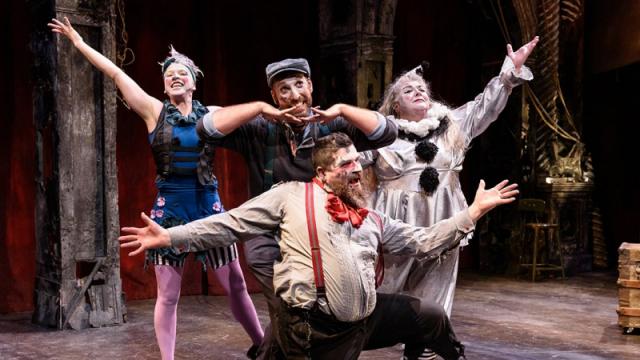
It's only natural for a show conceived in a former funeral home, where the characters remind us that we are an audience watching a Christmas play about an audience that died while watching a Christmas play, to benefit from the ambience of its real-life environment.
In the eight years since its premiere, Burning Bluebeard has played in a variety of settings, but the 1927-vintage Ruth Page Center for the Arts—home to its 2019 performance, filmed for this online videostream—most closely approximates the gilded-age Iroquois theater, site of the accident in 1903 that ushered in fire safety regulations still in effect today.
It began with a Christmas panto entitled “Mister Bluebeard,” whose Act Two "moonbeam" lights ignited a corner of the scenery, triggering a holocaust exacerbated by the management's failure to implement preventive measures, that left six hundred spectators dead fifteen minutes later. Jay Torrence's Burning Bluebeard presents us with the ghosts of five players, haunting the ruins of the scorched playhouse, endlessly repeating the first act of their cheerful comedy in hopes of turning back the clock to conclude the jolly entertainment they had planned, even as they struggle against remorse at their inability to rescue the people they sought to entertain.
In my review of last year's live performance, I reminded readers that the unlikelihood of nowadays being caught in a fire while watching a play is directly attributable to the six hundred women and children who perished in flames and to the survivors who crawled through the coal chute into the alley or jumped from the fire escapes to the pavement. The distance provided by watching on a screen from the security of your sofas may diminish the visceral thrill of solitary lanterns casting shadows onto charred walls, rendering the extensive exposition and epilogues protracted, but when the outside theaters open up again, you will arrive thereat with a new awareness of the reason behind that curtain raised in view of spectators before the start of a play, the absence of a Row "I" in seating plans, or, for that matter, why the adage regarding first amendment rights prohibits shouting "fire" in a crowded theater, rather than a church or a stadium.
